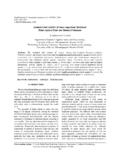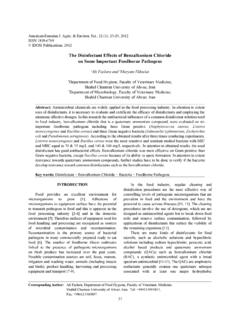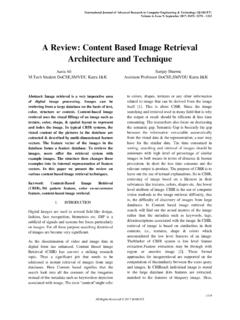Transcription of Prediction of Soil Exchangeable Sodium Percentage ... - IDOSI
1 American-Eurasian J. Agric. & Environ. Sci., 5 (1): 01-04, 2009. ISSN 1818-6769. IDOSI Publications, 2009. Prediction of soil Exchangeable Sodium Percentage Based on soil Sodium Adsorption Ratio 1. Mohsen Seilsepour, 2 Majid Rashidi and 3 Borzoo Ghareei Khabbaz 1. Varamin soil and Water Research Department, soil and Water Research Institute, Iran 2. Department of Agricultural Machinery, Faculty of Agriculture, Islamic Azad University, Takestan Branch, Iran 3. Department of Agricultural Machinery, Faculty of Engineering and Surveying, University of Southern Queensland, Australia Abstract: Despite the increasing prevalence of salinity world-wide, the measurement of Exchangeable cation concentrations in saline soil remains problematic.
2 In this situation, it is desirable to determine relationships among indices of soil salinity. Exchangeable Sodium Percentage (ESP) are often determined using laborious and time consuming laboratory tests, but it may be more appropriate and economical to develop a method which uses a more simple soil salinity index. In this study, a linear regression model for predicting soil ESP from soil Sodium Adsorption Ratio (SAR) was suggested and the soil ESP was estimated as a function of soil SAR. The statistical results of the study indicated that in order to predict soil ESP based on soil SAR the linear regression model ESP = + SAR with R2 = can be recommended.
3 Key words: Exchangeable Sodium Percentage Sodium adsorption ratio soil Prediction INTRODUCTION ESP = ( Na + / CEC ) 100 (2). Saline soils are of increasing importance both in Iran Where: and world-wide. In Iran, approximately M ha of ESP = Exchangeable Sodium Percentage , %. arable land are affected by dry land salinity [1]. In Na+ = Measured Exchangeable Na +, cmol kg 1. addition, poor quality of irrigation water may result in an CEC = Cation exchange capacity, cmol kg 1. increase in soil salinity. Salinity became a problem when enough salts accumulate in the root zone to As shown in Eq.
4 (2), for determining soil ESP, it is negatively affect plant growth. Excess salts in the root necessary to have soil Cation Exchange Capacity (CEC). zone hinder plant roots from withdrawing water from But, as soil CEC are often determined using laborious and surrounding soil . This lowers the amount of water time consuming laboratory tests [5, 6], it may be more available to the plant, regardless of the amount of water appropriate and economical to develop a method which actually in the root zone [2]. determines soil ESP indirectly from a more simple soil Two different criteria are currently recognized in salinity index.
5 The scientific literature as indices of salinity. These are Previously researches report a relationship between the Sodium Adsorption Ratio (SAR) with a reported soil ESP and SAR [7-9]. Thus, soil SAR can be used to threshold of 12 (cmol kg 1) and the Exchangeable approximate or estimate soil ESP. For this reason, many Sodium Percentage (ESP) with a reported threshold of attempts have been made to predict soil ESP from soil 15%. These are defined as Eq. (1) and Eq. (2) [2-4]: SAR. The United States Salinity Laboratory (USSL). proposed one of the earlier models to predict soil ESP.
6 SAR = Na + / (Ca 2+ + Mg 2+ ) / 2. from soil SAR as ESP = + SAR for United (1) States soils [7]. Since, the model developed by the USSL. has been derived from 59 arid-zone soils, the general Where: model between soil ESP and SAR has traditionally been ). SAR = Sodium adsorption ratio, (cmol kg 1 assumed to be similar to that. However, this model has Na+, Ca2+, Mg2+ = Measured Exchangeable Na+, Ca2+ and been shown not to be constant, but to vary substantially Mg2+, respectively, cmol kg 1 with both solution ionic strength and the dominant Corresponding Author: Dr. Majid Rashidi, Department of Agricultural Machinery, Faculty of Agriculture, Islamic Azad University, Takestan Branch, Iran 1.
7 Am-Euras. J. Agric. & Environ. Sci., 5 (1): 01-04, 2009. clay mineral present in the soil [10-13]. Therefore, the Table 1: The mean values, Standard Deviation ( ) and Coefficient of relationship between soil ESP and SAR is not constant Variation ( ) of soil physical and chemical properties of the and should be determined directly for the soil of interest. fifty-one soil samples used to determine soil ESP-SAR model Despite the considerable amount of research done, Parameters Minimum Maximum Mean (%). which shows the relationship between soil ESP and soil Sand (%) SAR, very limited work has been conducted to model Silt (%) soil ESP based on soil SAR.
8 Moreover, the mentioned Clay (%) predictive model is specific to a region or area and pH confined to only a few soil types. Therefore, the specific EC (dS m 1) objective of the study presented here was to determine a Na (cmol kg ). + 1. soil ESP-SAR model for Varamin soils in Iran and to verify Ca2++Mg2+ (cmol kg 1) the developed model by comparing its results with those SAR (cmol kg 1) of the laboratory tests. ESP (%) MATERIALS AND METHODS Table 2: The mean values, Standard Deviation ( ) and Coefficient of Variation ( ) of soil physical and chemical properties of the Experimental procedure: Fifty-one soil samples were fifteen soil samples used to verify soil ESP-SAR model taken at random from different fields of experimental site Parameters Minimum Maximum Mean (%).
9 Of Varamin, Iran. The site is located at latitude of 35 -19'N. Sand (%) and longitude of 51 -39'E and is 1000 m above mean sea Silt (%) level, in arid climate in the center of Iran. The soil of the Clay (%) experimental site was a fine, mixed, thermic, Typic pH Haplocambids clay-loam soil . EC (dS m 1) In order to obtain required parameters for determining Na+ (cmol kg 1) soil ESP-SAR model, some soil physical and chemical Ca2++Mg2+ (cmol kg 1) properties sand, silt and clay content (% by weight). SAR (cmol kg ) 1 and pH, EC, Na+, Ca2++Mg 2+, SAR and ESP of the soil ESP (%) samples were measured using laboratory tests as described by the soil Survey Staff [14].
10 Physical and chemical properties of the fifty-one soil samples used to In order to predict soil ESP from soil SAR, a linear determine the soil ESP-SAR model are shown in Table 1. regression model as above was suggested. Also, in order to verify the soil ESP-SAR model by comparing its results with those of the laboratory tests, Statistical analysis: A paired samples T-test and the fifteen soil samples were taken at random from different mean difference confidence interval approach were used fields of the experimental site. Sand, silt and clay content to compare the soil ESP values predicted using the soil (% by weight) and pH, EC, Na+, Ca2++Mg2+, SAR and ESP ESP-SAR model with the soil ESP values measured by of the soil samples were measured using laboratory tests laboratory tests.







